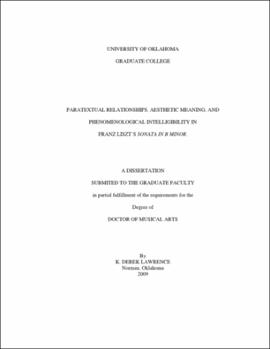| dc.contributor.advisor | Pederson, Sanna||Wagner, Irvin | |
| dc.creator | Lawrence, Kenneth Derek | |
| dc.date.accessioned | 2019-04-27T21:31:24Z | |
| dc.date.available | 2019-04-27T21:31:24Z | |
| dc.date.issued | 2009 | |
| dc.identifier | 99268247602042 | |
| dc.identifier.uri | https://hdl.handle.net/11244/318910 | |
| dc.description.abstract | When a performer approaches a score with the goal of crafting an interpretation, certain values are invariably assigned. The performer determines which edition of a score he will use, tempo relationships, dynamic ranges, and the meaning he will assign to the composer's notation. While composers have sought for all of recorded music history to make notation ever clearer, the truth remains that music is highly resistant to confinement in dots, lines, squiggles, and expressive terms. The performer must assign meaning to the notation based on his personal experience and knowledge every time he crafts an interpretation. This meaning encompasses aesthetic elements, musical gestures, and phrasing decisions. Thus, when performers discuss interpretation, there remains little of the score that has not been affected either consciously or unconsciously by the performer's subjective decisions. In music that includes extra-musical meaning, the situation becomes even more difficult. The performer must make decisions about musical notation, extra-musical programs, paratexts, performance practice, performance traditions, and what constitutes the "score" his performance must conform to. | |
| dc.description.abstract | Franz Liszt's Sonata in B minor resides at the crux of arguments over absolute and program music, aesthetic judgment, and interpretation. In order to negotiate between competing philosophies and interpretive traditions, one must construct a more nuanced description of the relationships between score, interpretation, performance, paratext, and aesthetic response. This study approaches the Sonata from a Faustian perspective using codes of aesthetic response to match major thematic and formal ideas with major characters and formal constructions in Goethe's Faust. | |
| dc.format.extent | 146 pages | |
| dc.format.medium | application.pdf | |
| dc.language | en_US | |
| dc.relation.requires | Adobe Acrobat Reader | |
| dc.subject | Music--Interpretation (Phrasing, dynamics, etc.) | |
| dc.subject | Sonata form | |
| dc.title | PARATEXTUAL RELATIONSHIPS, AESTHETIC MEANING, AND PHENOMENOLOGICAL INTELLIGIBILITY IN FRANZ LISZT'S SONATA IN B MINOR | |
| dc.type | text | |
| dc.type | document | |
| dc.thesis.degree | D.M.A. | |
| ou.group | Weitzenhoffer Family College of Fine Arts::School of Music | |
